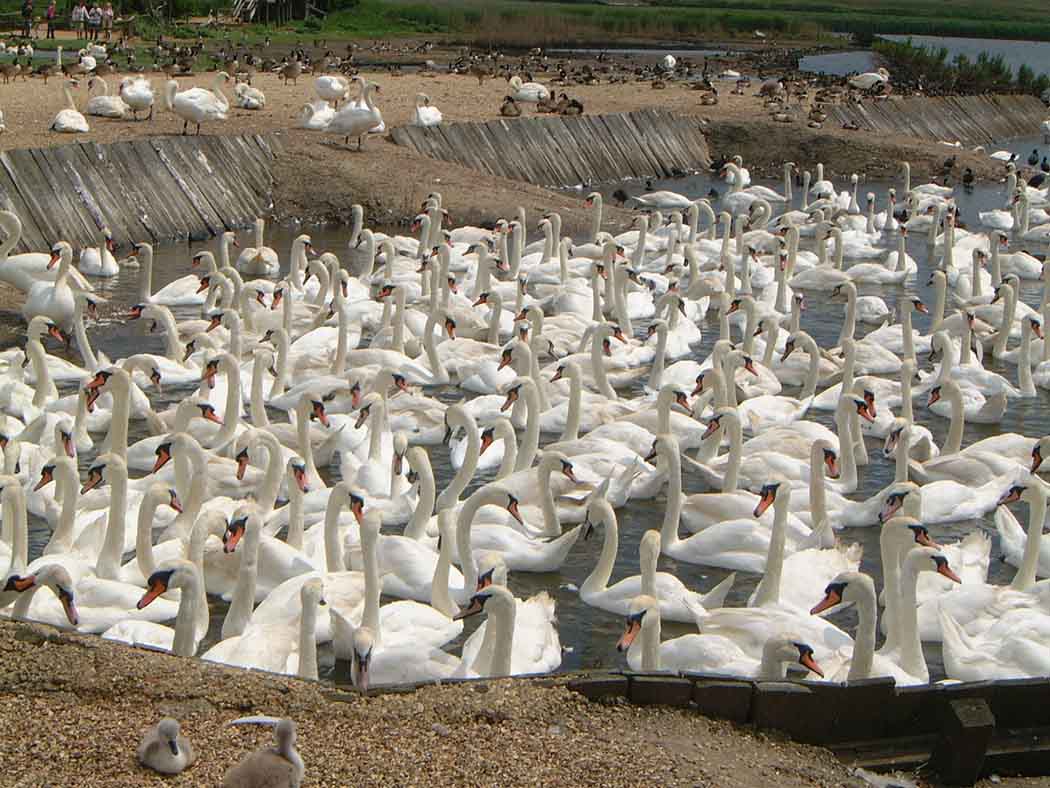
It didn’t take a lot ornithological nous to realise that nine Mute Swans with H5N8 bird flu virus in Dorset were quite likely to have come from Abbotsbury Swannery – as surmised in this blog on Saturday and trumpetted by the national press yesterday (Guardian, Telegraph, BBC). Defra doesn’t test additional birds from a location once the virus is confirmed so there may be many more Abbotsbury Mute Swans which have died from bird flu over and above the nine carcasses which contained the virus (and are assumed to have died because of it). About twice as many Mute Swans have died at Abbotsbury this winter (c80) compared with a normal winter. Interestingly it appears that young birds (hatched this year) make up most of the birds which have died.
There continues to be speculation on Twitter about Pheasants and bird flu. This is hardly surprising since the Pheasant is the UK’s most numerous ‘wild, but not really wild’ bird because 35 million (or 45 million, or 50+ million depending on who you believe) Pheasants are released into the countryside every year for ‘sporting’ purposes. If you have an exceptionally good memory of this blog, then you will recall that nearly three years ago I asked my then MP, Andy Sawford, to ask Defra some questions about Pheasant and Partridge imports (see here, here and here).
The second of those posts sets out the official figures on numbers of Pheasant, partridge and ‘galliform’ poults imported into the UK each year – almost 8 million. That is a lot of birds, hatched abroad, transported to the UK, kept in pens and then they become, as if by magic, wild birds when released to be shot. But from the point of view of bird flu I assume that most of these birds are imported in the summer and not at this time of year – is that right does anyone know?
Defra also wrote at that time: Pheasants are not generally considered a risk of transmission of avian influenza: these viruses are usually found in wildfowl and it is contact with wild or farmed ducks, geese etc that is high risk.
Of course you will find more bird flu in waterfowl if those nice people at Abbotsbury, WWT and RSPB send in lots of dead ducks, geese and swans for analysis and Pheasant shooters don’t, so on the face of it we shouldn’t give too much weight to the reported number of positive cases in particular species or groups of species. There may be a danger of confirmation bias here. It’s not clear that Defra records the number of negative cases by species so it may not be possible to compare the percentages of positive and negative tests by species.
I’ve asked the Defra Chief Vet, Nigel Gibbens, on Twitter (@ChiefVetUK) about whether any Pheasants have been tested for H5N8 but he hasn’t replied. This is fair enough as I am sure he has a lot on his plate. But an FoI will be heading his way once we get past this outbreak of H5N8.
It’s all very rudimentary stuff, and I fear that useful information on wild birds and H5N8 isn’t being collected. All too often in my past dealings with Defra vets it seemed that a wild bird was a wild bird was a wild bird, rather than them being different species with different ecologies and movement patterns which would affect their likelihood of transmitting avian flu viruses.
[registration_form]
I’m glad you have raised the issue of pheasants as they are frequent visitors to my garden and I have been pondering for years just what impact they could have on various infectious diseases including bird flu. I cannot see how c. 40m birds can have no impact and if DEFRA are claiming it’s mainly wildfowl and farmed ducks and geese that are at risk then why the hell I am being required to keep my five domestic chickens locked up for months (on pain of a £5k fine) with strict instructions about preventing ‘any wild bird’ defecating into their wire run?
Three of my hens have been recently rescued from death at the end of their useful contribution to a local factory egg farm. They arrived in a dreadful state of anaemia, feather loss and general unfitness but have quickly recovered to become fit, healthy and covered in lovely russet plumage. The had just got used to a genuinely free-rage lifestyle in our little orchard when they had to be locked up again.
It seems this has been imposed on them to protect the very unpleasant ‘industrial’ farming they managed to escape from with their lives, and it seems even more unfair that they get to watch dozens of pheasants on the other side of the wire enjoying their freedom having been introduced into the countryside by another industrial process, this time for the sole benefit of those who are amused by killing them for fun.
I have long supported your case for banning driven grouse shooting but, given the impact these 40 million pheasants have on our own wild species (competing for food, killing various species such as small reptiles etc. and now the risk of bird flu), I can’t help thinking that pheasant shooting should be stopped as well. It serves no useful function whatsoever.
“It serves no useful function whatsoever”
That could start a long list
Let’s just hope that DEFRA don’t go down the last Foot and Mouth outbreak road.
I’m still noticing poultry ‘exposed’ to the environment – is this presently illegal?
A well known Scottish Game keeper has been posting photos of his pet fowl wandering about in the open….. oops?